02/01/22 - DEBBIE EVANS AND LANE LEAVITT WHAT A COUPLE! TRIALS AND MOVIES ...
Debbie Evans and Lane Leavitt, what a couple! In the seventies trials riders, then movie stunt performers (still now) , and for a brief parenthesis in the late nineties trials rider again called back to push for a world acknowledgement for female competitors.
A couple who have successfully shared a “Vita Speracolata” (famous song Vita by Italian singer Vasco Rossi - tradution reckless life).
Phototrial had the pleasure of meeting both on the occasion of two international women's events in September 1998 and 1999, held in Torre Pellice, Italy, resulted then preparatory for the establishment of a real Women's World Championship.
So, the focus has always been on the Californian Debbie Evans, already known in the European environment for the brilliant performance in the Six Days of Scotland in 1978. Riding a Yamaha TY 175 she finished in 108th place, but the photo that went around the globe - not as quickly as today, due to that time - was while she is in static balance on a trials motorcycle upside down with her head on the seat.
To race in Europe, Yamaha USA sponsored her trip and in Scotland she found support from Bill Emmison of BERM Specialities, a UK company which imported US off-road products and precious race pieces of advice from Mick Wilkinson and Rob Shepherd, close to her in that competition.
A detailed report on that experience and her life as a stunt woman was published by John Moffat on his site, www.trialsguru.com.. Moreover there is on Youtube a one-hour-video on her, having entered the US pilots awarded the "American Legend" title, here it is : www.youtube.com
This time – sorry Debbie - in the spotlights we put her husband, the first US National Trial Champion, Lane Leavitt, who was US number one in 1972,1973 and 1974.
The temporal location is that of the late 60s, early 70s: in Europe Trials was still a massively English phenomenon and in the north of the old continent with new outbreaks in France and Spain, a nation in which it was about to explode thanks to the impressive arrival of highly innovative industries and engines.
But little was known overseas, how did you discover the Trial, Lane, how old were you?
I was 19 when I competed for the first time in the fall of 1969 on a Hodaka Ace 100. I used to ride with my High School pals, and some married adult friends, who we rode Enduros with. For some reason, we all decided we would go ride a Trial up in beautiful Marine County. Why we all began riding Trials and quit Enduros I don’t really remember, but I depended on my married adult friends to carry my Hodaka to any events we did, because I didn’t have a pick-up, all I had was my 1956 Chevy Bel Air Hot Rod with a 4 speed Munci Tranny, and Tuck and Roll interior.
What did it mean to race in the Trial at that time?
We all lived the movie American Graffiti lifestyle, we cruised the boulevard at night with my Car Club, The Coachmen of Pleasanton, and rode Motorcycles during the day. If you have any doubts of how wild our lifestyle was, ask Kirk Mayfield, who came and stayed with me the summer of 73, Kirk said to me recently, it was the best, the wildest and the greatest summer of his lifetime.
Why Trial and not Motocross, much more popular?
My folks refused to sign the release for me to go Motocross racing, so I decided to focus on Trials I was not 18 yet Trials at that time did not require a release, so I decided to compete in Trials until I turned 18, then quit and go MX racing.
What was your first real Trial bike? Did your parents buy it for you?
I lived at home, and had an extremely good paying job building swimming pools that allowed me to purchase my first real trials machine, a brand new 1970 Montesa Cota 247, I choose the Cota, because its the bike that the European Champ was riding, Don Smith.
On this machine, I had my first solid Championship win, the Pacific Trials Championship in Gilroy California This win made me Champion of NorCal, and gave me the confidence I needed to begin venturing out around the nation. By that time I had changed jobs and was working nights a General Motors Parts division in Oakland, which allowed me to train all day, and work 8 hours at night. This combination of self funding, and the time and enthusiasm to train, was perfect for improving my performances.
How did you get to know about the Trial races at that time?
Reading Cycle News newspaper, we were very fan of it. As the latest issue would show up on Wednesday morning at the motorcycle shop, we got it, in which we found all the results of the previous week, and advertised the upcoming events around the western US.
You were one of the pioneers of the El Trial De Espana, that race held in California and which as a prize has a trip to Europe with its race in Spain, right?
Yes, the very first edition was in 1970. It happened that one week I noticed that the Souther California Trials Association was promoting an event called the El Trial De Espana at Saddleback park in So Cal (South California nda) , and that the club was sending their best two riders to Spain for the World Round. I had to go, just to see how I staked up against the SoCal riders.
I was all trained up, my bike was working well, so I loaded up my Hot Rod brand new Ford Supervan, with its custom wheels, which was totally tricked out for cruising, it was about the coolest hauler anybody could have in 1970. Then headed for Saddleback. I traveled alone, nobody else was crazy enough to travel that far to ride a Trial but me, and I was a man on a mission. Which was to beat the two riders the SCTA were sending to Europe to represent the USA.
Arriving that night before the Trial, I slept in the driveway going up to the Motorcycle Park in my van, just me and my Motorcycle. Then the next day, I spanked the top two SoCal riders really good, making me the very first winner of the El Trial De Espana. Montesa importer, Fred Belair was thrilled, and was out of his mind happy: a Montesa rider showed up out of nowhere and beat the Ossa and Bultaco riders who they were sending to Spain, I don’t believe I have ever seen Fred so happy ever.
Did this allow you to become an official rider?
Winning El Trial # 1 opened the doors of sponsorship for me. Montesa offered to trade my old bike for a new on for free. But Bultaco contacted my and literally rolled out the Red Carpet, by offering me free parts, 2 new motorcycles, and $250 for every trial I won, $150 for 2nd and $75 for 3rd, which was good money back in 1971, considering a new Corvette Stingray was under $4 Grand.
Me switching to Bultaco crushed Fred Belair, and he never forgave me, but Bultaco just gave me an offer I could not refuse, and remember I really didn’t want to ride Trials, what I wanted was to go Racing, but this free bike and parts thing was awesome.
Is it true that you refused to receive cash prizes?
True, I won almost every trial I rode, but I never collected the win money from Bultaco, because I felt guilty taking money for riding Trials, which I thought was fun, and I didn’t feel comfortable getting paid to play.
What do you remember particularly about your career with Bultaco?
I rembember when I was asked to ride Trials in Colorado: the Great Victor Trial in Leadville. The local Bultaco dealer wanted to show the Sherpa T’s he was selling could compete against the Montesa Cota, which was dominating all the events out there. Bultaco asked me to fly out to Colorado to ride a Trial by the request of that local dealer! It was fantastc: nobody flys to a Trial, except maybe Mick Andrews or Sammy Miller!
Happy to try, I flew out, borrowed a bike and won that event too. I still didn’t collect any win money, becuase I still felt too guilty to give them a bill for riding a Trial.
At this point you felt like an official Bultaco rider, had you abandoned the desire to race in cars?
Absolutely not. It is curious as any time I was on the edge to quit in Trials and to start a new adventure in Car racing, Bultaco importer called me offering important challeges I did not have the courage to miss.
Eg?
When I was asked to ride the El Trial # 2 because Bultaco was providing a Free Trip to Spain for the 10th San Antonio Trial at the Bultò family ranch. I went down, rode and won, gaining the free trip. It was amazing: all the newspapers covered this story, including the Oakland Tribune which made Bultaco extremely happy, and me a hot property as a Trial rider.
Another time, when I had actually retired from Trials, Bultaco asked me to go to Saddleback Park for riding against the Montesa Factory rider, Rob Edwards from Europe, sent for a promotional tour in the USA. I said no, but they insisted requesting me to go and represent Bultaco once again. As in the past I had a good ride and would have beaten Rob Edwards, but as the organizers realizing I was going to win, simply because Rob wouldn't finish his 3rd loop in time, they abruptly dropped the 3rd loop just as I was racing in to collect my 3rd lap scorecard. This decision enabled Rob to finish on time, beating my score.
Not bad for my last trial I thought! Almost beating the Factory rider from Europe, and I would have if the organizers had not pulled the “Fast One” on me.
At that point, did you want to compete in Trial again?
My idea was still moving to Sports Car racing, because there were not any professional Trials riders at that time, and to carry on riding trials seemed like a foolish return on my investment of time. But after that performance I was invited to a meeting by the executives of Bultaco America, in which they offered me a job riding trials. My mission was to follow Rob Edwards across the USA and compete against him in all the promotional events he will do for the major USA trials clubs.
Did you accept easily?
This was a scary decision: quitting my good paying job launching out into the unknown. Driving all the way across the USA and back all by myself. I took the leap of faith, and in the first Trial in Colorado, I beat Edwards, causing another insult via injury to the Montesa promotional department, where I was getting very unpopular. Being the very first person to ride with all the major US clubs was interesting. Nobody used the same rules, nobody used the same marking systems, so each new event was a game of mental chess to remember everything.
It is amazing, you were the first US professional rider, did you enjoy your new job?
Being a Pro Trial Rider is not fun, it’s actually one of the hardest jobs I have ever held, and I’ve had some tough ones. So when you see riders like Toni Bou, or Adam Raga, don’t envy them, the pressure up top is almost unbearable.
But winning events in Trials was not the biggest thrills of my Trials career, it was meeting my wife Debbie Evans, the cute little Yamaha factory rider, who has made me the best wife imaginable. Then how it all lead me into my career in Hollywood, which is really both Debbie’s and my calling, the Motion Picture and TV Action industry, which is where both of us have really left our mark in this world.
Did you compete in Car racing? How many years and where? What results?
Our car racing was much like what you see in the Fast and the Furious movies. Racing on the streets or at the local drag strip. But my plan if I had not become a professional trials rider for the factory. Was to go Road Racing with sportscars.
What was the best memory in your Motion Picture and TV Action industry career?
My best memory in the motion picture industry is the Stallone movie Cliffhanger. We spent 3 months in Cortina Italy, working on the mountaintops. We did some amazing stunts, and the Dolomiti left a lasting impression on me, I will never lose. I love Northern Italy.
What about your family? Are your children fond of Trials, too?
Yes but they are not as crazy as I was about it. I pulled my middle son aside when he was about 15 and said, lets train for Hollywood, there is no real future in Trials. My other two kids, just ride a little bit.
What was your reaction in 1998, when Laura Bussing (or me I do not remember) called Debbie back to competions?
Calling Debbie back to compete, It was not Laura, it was me. I spent about 6 months trying to convince her to ride again. Finally she gave in, and she trained about 6 weeks for the Trial. Overall she did ok, finishing 8th after an 18 year layoff and having 3 kids. She rode all the way up to about 2003 on the US TDN team, until she was seriously hurt on a movie. She was out of serious trials forever after that accident, and had to learn to walk again. She can still ride, but only for fun now.
What can you say of your double experience in Italy at Torre Pellice?
My experience at your event? It was amazing, and it brought so many good memories of international trials and the people involved, and how special and wonderful they are. We also attended several TdNs and reconnected with so many people we knew back in the 70s. Plus made so many new friends in the international sport. It was incredible.
Debbie feels exactly as I do, your events were such a great experience. What a great bunch of athletes we met, and got to know. Thank you
Some news and photos from John Moffat (www.trialsguru.com)
---------------------------------------------------------------------------------------
DEBBIE EVANS E LANE LEAVITT CHE COPPIA! DAL TRIAL AL CINEMA ...
Debbie Evans e Lane Leavitt, che coppia! Negli anni settanta trialisti, poi stuntman cinematografici (ancora adesso), e per una breve parentesi alla fine degli anni novanta dinuovo nel Trial, per ottenere un riconoscimento mondiale per le concorrenti femminili.
Una coppia che ha condiviso con successo una “vita spericolata” per dirla alla Vasco Rossi.
Phototrial ha avuto il piacere di conoscere entrambi in occasione di due eventi internazionali femminili a settembre 1998 e 1999, svolti a Torre Pellice, che sono poi risultati propedeutici all'istituzione di un vero e proprio campionato mondiale femminile.
Allora, l'attenzione maggiore si focalizzò sulla californiana Debbie Evans già conosciuta nell'ambiente europeo per la brillante prestazione nella Sei Giorni di Scozia del 1978. Alla guida di una Yamaha TY 175 si classificò al 109° posto, ma la foto che fece il giro del globo – non così rapidamente come oggi, visti i mezzi dell'epoca – fu quella che la ritraeva a testa in giù in appoggio sulla sella e in perfetta verticale in equilibrio sulla sua cavalcatura.
Per correre in Europa la Yamaha USA sponsorizzò il suo viaggio e in Scozia trovò appoggio in Bill Emmison della BERM Specialities, una comagnia inglese che importava prodotti di moto fuoristrada USA e preziosi consigli in gara da Mick Wilkinson and Rob Shepherd , vicini a lei di numero.
Un dettagliato articolo su quella esperienza e sulla sua vita da stunt-woman è stato pubblicato da John Moffat su www.trialsguru.com. C'è anche un video di circa un'ora su Youtube, perchè entrata nei piloti statunitensi insigniti del titolo “American Legend”, eccolo: www.youtube.com
Questa volta – non ce ne voglia – sotto le luci della ribalta ci va suo marito, il primo campione nazionale statunitense di Trial, Lane Leavitt, che vinse il titolo nel 1972,1973 e 1974.
La collocazione temporale è quella di fine anni 60, inizio anni 70: in Europa il Trial era ancora un fenomeno massicciamente inglese e del nord del vecchio continente con nuovi “focolai” in Francia e in Spagna, nazione nella quale stava per esplodere, grazie all'arrivo imponente di industrie e motori altamente innovativi.
Ma oltre oceano ben poco si sapeva, come hai fatto a scoprire il Trial, Lane, che età avevi?
Avevo 19 anni quando ho gareggiato per la prima volta nell'autunno del 1969 su una Hodaka Ace 100. Andavo sulla moto da Trial con i miei amici del liceo e alcuni amici adulti sposati, con cui si praticava l'Enduro. Per qualche ragione, abbiamo deciso tutti che saremmo andati a fare un Trial nella bellissima Marine County. Non ricordo bene il motivo per cui tutti abbiamo iniziato a dedicarsi ai Trials e abbiamo lasciato l'Enduro, ma dipendevo dai miei amici adulti per trasportare la mia Hodaka alle gare , perché non possedevo un pick-up. Tutto ciò che avevo era la mia Chevy Bel Air Hot Rod del 1956 con Munci Tranny a 4 velocità e interni Tuck and Roll.
Cosa significava correre nel Trial a quell'epoca?
Abbiamo vissuto tutti lo stile di vita del film American Graffiti: gareggiavamo in auto nei viali di notte con il mio Car Club, The Coachmen of Pleasanton e andavamo in moto di giorno. Se hai dei dubbi su quanto fosse trasgressivo il nostro stile di vita, chiedi a Kirk Mayfield, che è venuto a stare con me l'estate del 73. Di recente Kirk mi ha detto che fu la migliore, la più spericolata e la più grande estate della sua vita.
Perchè il Trial e non il Motocross, molto più popolare?
I miei si rifiutarono di firmare la liberatoria per me per correre nel Motocross, quindi decisi di concentrarmi sul Trial. Non avevo ancora 18 anni, le gare di Trial a quel tempo non richiedevano un'autorizzazione, quindi decisi di gareggiare nel Trial fino a quando non avessi compiuto 18 anni, per poi passare al Motocross.
Qual è stata la tua prima moto realmente da Trial? Te l'hanno comprata i tuoi genitori?
Vivevo coi miei, e avevo un lavoro estremamente remunerativo nella costruzione di piscine che mi permise di acquistare la mia prima vera moto da Trial, una Montesa Cota 247 del 1970, nuova di zecca. Scelsi la Cota, perché era la moto che stava guidando il Campione Europeo, Don Smith.
Su questa moto, ottenni la mia prima solida vittoria del campionato, il Pacific Trials Championship a Gilroy in California. Questa vittoria mi rese Campione del Nord California e mi diede la fiducia di cui avevo bisogno per iniziare ad avventurarmi in giro per la California, A quel tempo avevo cambiato lavoro e lavoravo di notte in una divisione della General Motors Parts a Oakland, il che mi permetteva di allenarmi tutto il giorno, pur lavorando 8 ore di notte. Questa combinazione di autofinanziamento e tempo ed entusiasmo per allenarmi risultò perfetta per migliorare le mie prestazioni.
Come si veniva a conoscenza delle gare di Trial a quell'epoca?
Leggendo il settimanale Cycle News, ne eravamo molto appassionati. Sapendo che usciva il mercoledì mattina presso il negozio di moto, non vedevamo l'ora di acquistarlo. Vi si trovavano tutti i risultati della settimana precedente e venivano pubblicizzati i prossimi eventi negli Stati Uniti dell'ovest.
Sei stato uno dei pionieri del El Trial De Espana, quella gara che si tiene in California e che come premio ha un viaggio in Europa con relativa gara in Spagna?
Sì, la primissima edizione fu nel 1970. Un giorno notai che la Souther California Trials Association stava promuovendo un evento chiamato El Trial De Espana al Saddleback Park nel sud, e che il club avrebbe mandato i loro due migliori piloti in Spagna per il World Round. Dovevo andare, solo per misurare il mio livello contro i piloti del sud California (SoCal).
Ero ben allenato, la mia moto funzionava bene, quindi la caricai sul mio Ford Supervan Hot Rod nuovo di zecca, con ruote maggiorate, motore truccato, il furgone più bello che si potesse avere nel 1970, diretto a Saddleback. Viaggiai da solo, nessun altro era abbastanza pazzo da andare così lontano per partecipare ad un Trial tranne me. Ma avevo la mia missione: battere i due piloti che la SCTA (Sud California Trial Associazione, una sorta di federazione nda ) stava inviando in Europa per rappresentare gli Stati Uniti.
Arrivato la notte prima del Trial, dormii nel mio furgone, parcheggiato nel vialetto che saliva al Parco Moto: solo io e la mia moto. Poi il giorno dopo, strapazzai i primi due piloti SoCal davvero bene, diventando il primo vincitore dell'El Trial De Espana. L'importatore Montesa, Fred Belair fu sconvolto, raggiante di felicità: un pilota Montesa sbucato dal nulla, aveva battuto i piloti Ossa e Bultaco che stavano mandando in Spagna! Non credo di aver mai visto Fred così felice.
Questo ti permise di diventare un pilota ufficiale?
Vincere la prima edizione di El Trial mi aprì le porte della sponsorizzazione. La Montesa mi offrì di cambiare gratuitamente la mia vecchia moto con una nuova. Ma la Bultaco mi contattò e mi stese letteralmente il tappeto rosso, offrendomi ricambi gratuiti, 2 nuove moto e $ 250 per ogni vittoria, $ 150 per ogni secondo posto e $ 75 per il terzo, che era un bel gruzzolo nel 1971, considerando che una nuova Corvette Stingray costava meno di 4 mila dollari.
Il passaggio alla Bultaco fu una grande delusione per Fred Belair, che lo me lo perdonò mai, ma quell'offerta non si poteva rifiutare. E pensare che non avrei voluto correre nel Trial, quello che volevo era correre con le auto, ma queste moto gratis coi ricambi fu fantastico.
E' vero che ti rifiutavi di ricevere premi in denaro?
È vero, ho vinto quasi tutte iTrial che ho corso, ma non ho mai intascato i soldi della vittoria dalla Bultaco, perché mi sentivo in colpa a prendere denaro per fare qualcosa in cui mi divertivo: non mi sentivo a mio agio a essere pagato per giocare.
Cosa ricordi di particolare della tua carriera con la Bultaco?
Ricordo quando mi è stato chiesto di andare a una gara in Colorado: il Great Victor Trial a Leadville. Il rivenditore Bultaco locale voleva dimostrare che la Sherpa T che stava vendendo, poteva competere con la Montesa Cota, dominatrice di tutti gli eventi. Bultaco mi chiese di volare in Colorado per correre su richiesta di quel rivenditore locale! Fu fantastico: nessuno vola a un Trial, tranne forse Mick Andrews o Sammy Miller! Felice di provare, presi l'aereo, poi il rivenditore mi prestò una moto e vinsi anche quell'evento. Non ritirai il denaro per la vittoria, perché mi sentivo ancora troppo in colpa per presentare loro il conto per aver gareggiato.
A questo punto ti sentivi pilota ufficiale Bultaco, la voglia di correre nelle auto l'avevi abbandonata?
Assolutamente no. È curioso come ogni volta che ero sul punto di abbandonare i Trials e iniziare una nuova avventura nelle corse automobilistiche, l'importatore Bultaco mi chiamasse, offrendomi sfide importanti che non ebbi il coraggio di perdere.
Ad esempio?
Quando mi fu chiesto di andare alla seconda edizione del El Trial de Espana perché la Bultaco stava fornendo un viaggio gratuito in Spagna per la decima edizione del Trial di San Antonio al ranch della famiglia Bultò. Ci andai e vinsi, guadagnando il viaggio gratuito. Fu fantastico: tutti i giornali raccontarono questa storia, incluso l'Oakland Tribune che rese l'importatore Bultaco estremamente felice e io una risorsa preziosa come pilota di Trial.
Un'altra volta, quando mi ero già ritirato dal Trial, Bultaco mi chiese di andare al Saddleback Park per gareggiare contro il pilota ufficiale Montesa, Rob Edwards dall'Europa, inviato per un tour promozionale negli Stati Uniti. Dissi di no, ma insistettero chiedendomi di andare a rappresentare la Bultaco ancora una volta. Come in passato, feci un buon giro e avrei battuto Rob Edwards, ma quando gli organizzatori si resero conto che stavo per vincere, semplicemente perché Rob non avrebbe finito il suo terzo giro in tempo, cancellarono il terzo giro. Questa decisione permise a Rob di finire in tempo, battendo il mio punteggio.
Non male per la mia ultima gara, pensai! Quasi sconfissi il pilota factory dall'Europa, e l'avrei fatto se gli organizzatori non mi avessero giocato contro.
A quel punto ti è tornata la voglia di gareggiare in Trial?
La mia attenzione era ancora orientata alle corse di Sportscar, perché a quel tempo non c'erano piloti professionisti di Trials, e continuare a correre sembrava un inutile investimento del mio tempo. Ma dopo quella performance venni invitato a una riunione coi dirigenti di Bultaco America, in cui mi venne offerto un lavoro come pilota. Il mio compito sarebbe stato seguire Rob Edwards in tutti gli Stati Uniti e competere contro di lui in tutti gli eventi promozionali che si sarebbero tenuti per i maggiori trial club statunitensi.
Tu accettasti facilmente?
Quella fu una decisione estremamente difficile: lasciare il mio lavoro ben pagato per lanciarmi nell'ignoto. Macinando chilometri da solo attraverso gli Stati Uniti. Feci questo salto nel buio. Alla prima gara in Colorado sconfissi Edwards, dando un altro schiaffo al reparto promozionale della Montesa, dove stavo diventando molto impopolare.
Essere la prima persona a correre con tutti i maggiori club statunitensi fu interessante. Nessuno usava le stesse regole, nessuno usava gli stessi sistemi di conteggio, quindi ogni nuovo evento era una partita a scacchi mentale per ricordare tutto.
È incredibile, sei stato il primo pilota professionista statunitense, ti è piaciuto il tuo nuovo lavoro?
Essere un pilota professionista di Trial non è così divertente: in realtà è uno dei lavori più tosti che abbia mai svolto e ne ho avuti di difficili. Quindi, quando vedi piloti come Toni Bou o Adam Raga, non invidiarli, la pressione che subiscono è quasi insopportabile.
Ma vincere le gare non è stata la più grande emozione della mia carriera nel mondo del Trial. Lo è stato incontrare mia moglie Debbie Evans, la bella pilotessa ufficiale Yamaha, che è poi divenuta la migliore moglie che si possa immaginare.
E poi come tutto questo mi abbia portato nella mia carriera a Hollywood, che si è rivelata essere sia la mia vocazione che quella di Debbie: l'industria cinematografica e d'azione televisiva, che è dove entrambi abbiamo davvero lasciato il segno in questo mondo.
Hai gareggiato nelle corse automobilistiche?
Le nostre corse automobilistiche erano molto simili a quelle che vedi nei film Fast and Furious. Corse per le strade o “dragstrip” locali. Ma il mio piano se non fossi diventato un pilota ufficiale professionista di Trial sarebbe stato le Road Racing con auto sportive.
Qual è stato il ricordo più bello della tua carriera nell'industria cinematografica e d'azione televisiva?
Il mio miglior ricordo nell'industria cinematografica è il film di Stallone, Cliffhanger. Abbiamo trascorso 3 mesi a Cortina in Italia, lavorando sulle cime delle montagne. Abbiamo fatto delle acrobazie incredibili e le Dolomiti hanno lasciato un ricordo impressionante che non dimenticherò mai. Amo il nord Italia.
Anche i tuoi figli sono appassionati di Trial ?
Sì, ma non ci vanno matto come facevo io. Ho preso da parte il mio secondogenito quando aveva circa 15 anni e gli ho detto, allenati per Hollywood, non c'è un futuro nel Trial. Gli altri miei due figli, usano la moto per divertimento.
Qual è stata la tua reazione nel 1998, quando Laura Bussing (o io non ricordo) richiamò Debbie alle gare?
A richiamare Debbie per gareggiare, non fu Laura, ma io. Ci vollero circa 6 mesi per convincerla a correre di nuovo. Alla fine cedette e si allenò per circa 6 settimane per il Trial. Nel complesso fece bene, finendo ottava dopo un interruzione di 18 anni e aver partorito 3 volte. Ha corso fino al 2003 circa, nella squadra statunitense al TdN, fino a quando non fu gravemente ferita in un film. Dopo quell'incidente non potè mai più correre nel Trial. Dovette imparare di nuovo a camminare. Ora va ancora in moto, ma solo per divertimento.
Cosa puoi dire della tua doppia esperienza in Italia a Torre Pellice?
La mia esperienza al tuo evento? Fu straordinario e portò così tanti bei ricordi di Trial internazionali e delle persone coinvolte, di quanto fossero speciali e meravigliosi. Partecipammo anche a diversi Trial delle Nazioni, rimettendoci in contatto con così tante persone che conoscevamo negli anni '70. Inoltre stringemmo amicizie con tanta altra gente nello sport internazionale. Fu incredibile.
Debbie la pensa esattamente come me, i tuoi eventi sono stati un'esperienza fantastica. Che bel gruppo di atleti abbiamo incontrato e conosciuto. Grazie
------------------------------------------------------------------------------------------

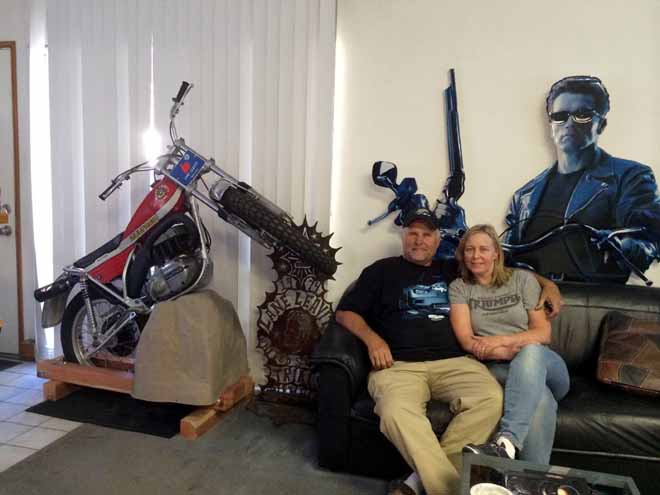
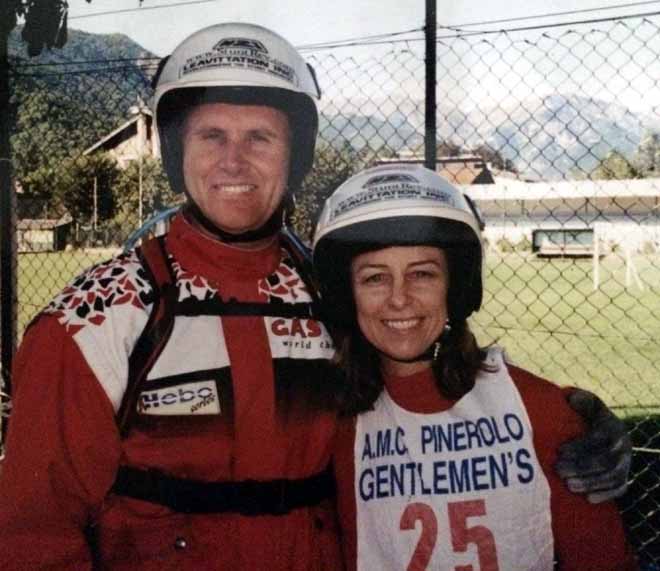
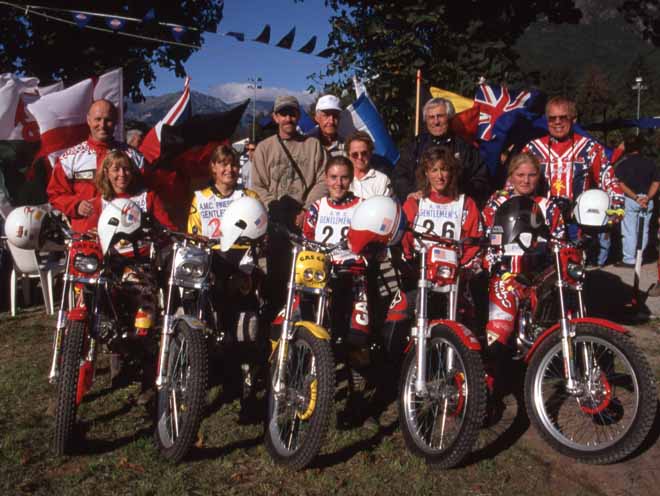

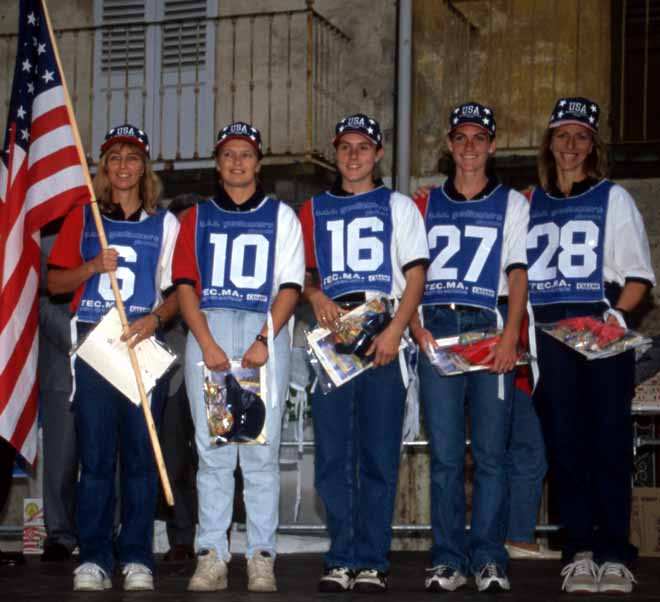
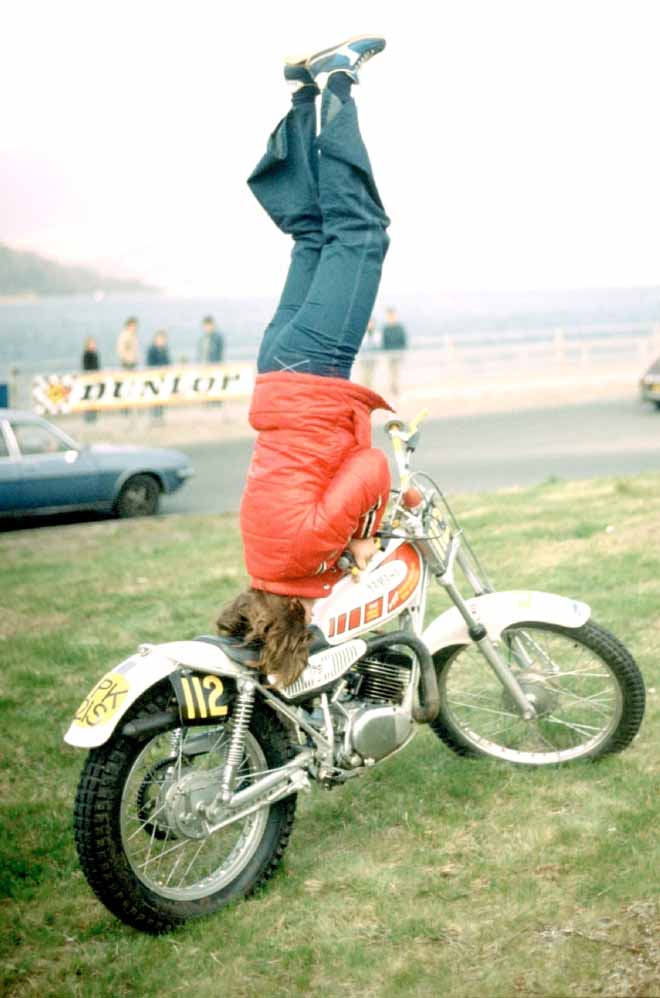
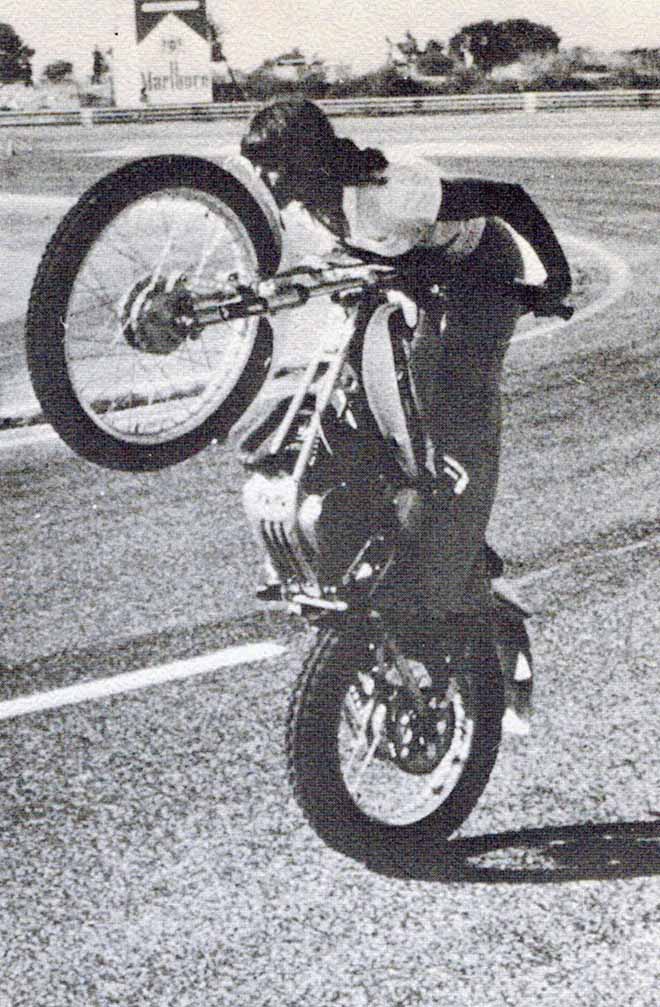
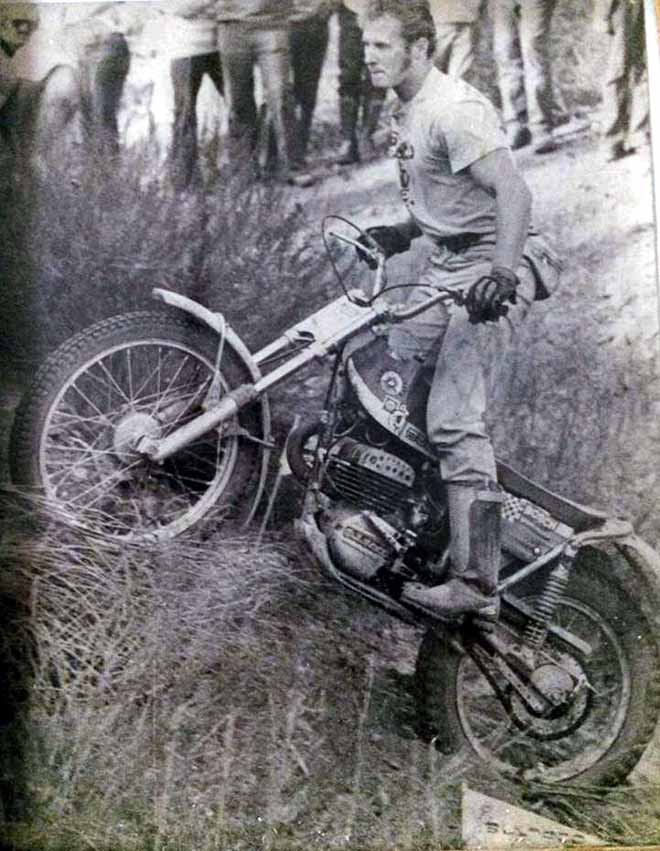
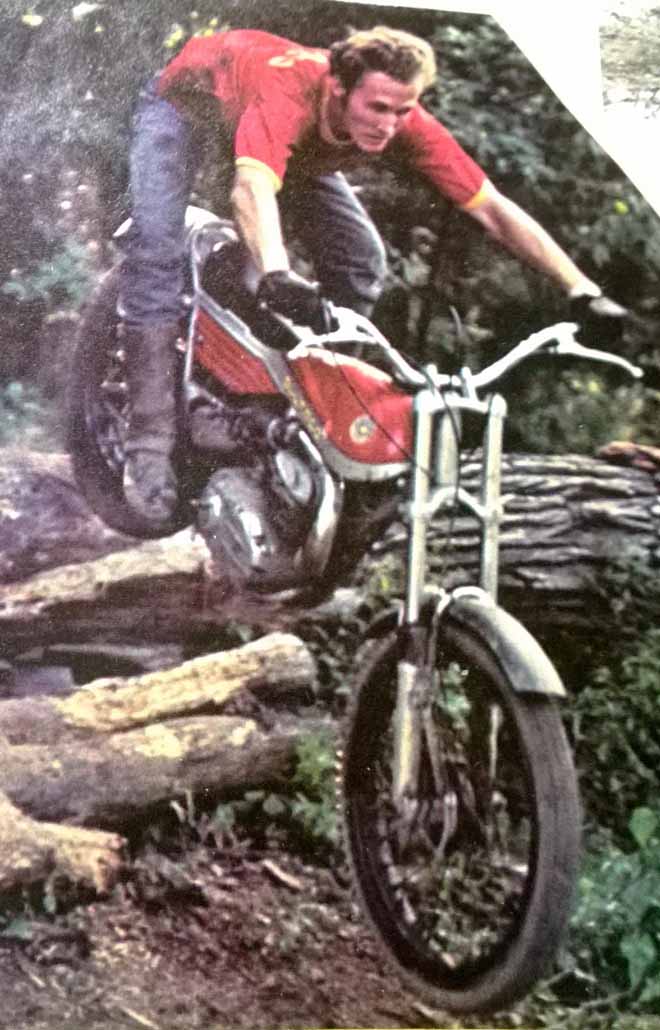
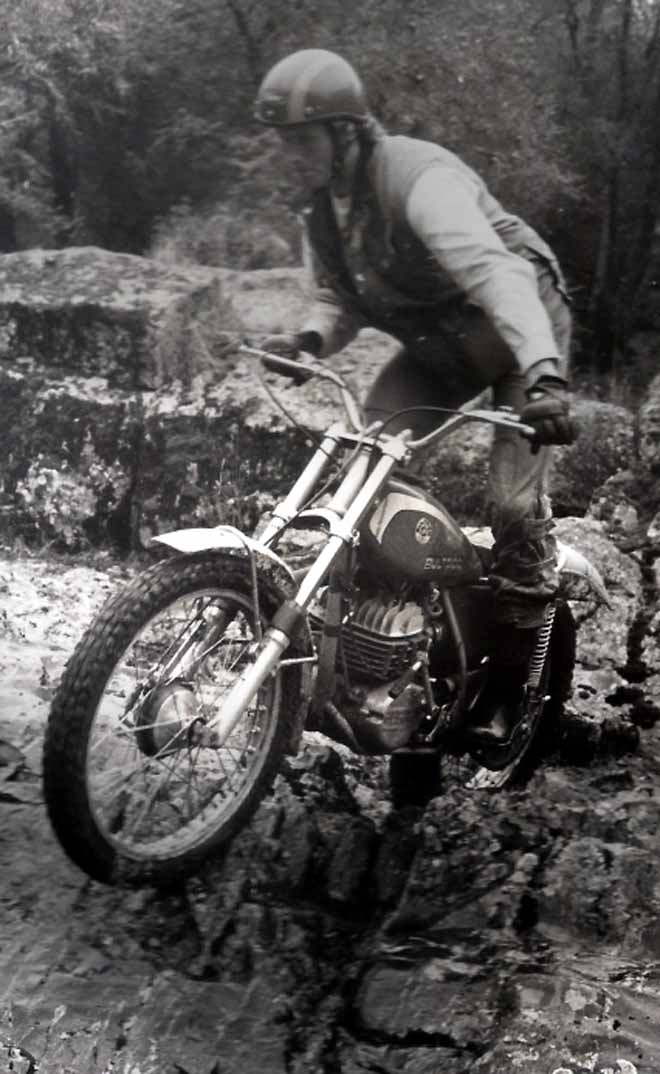
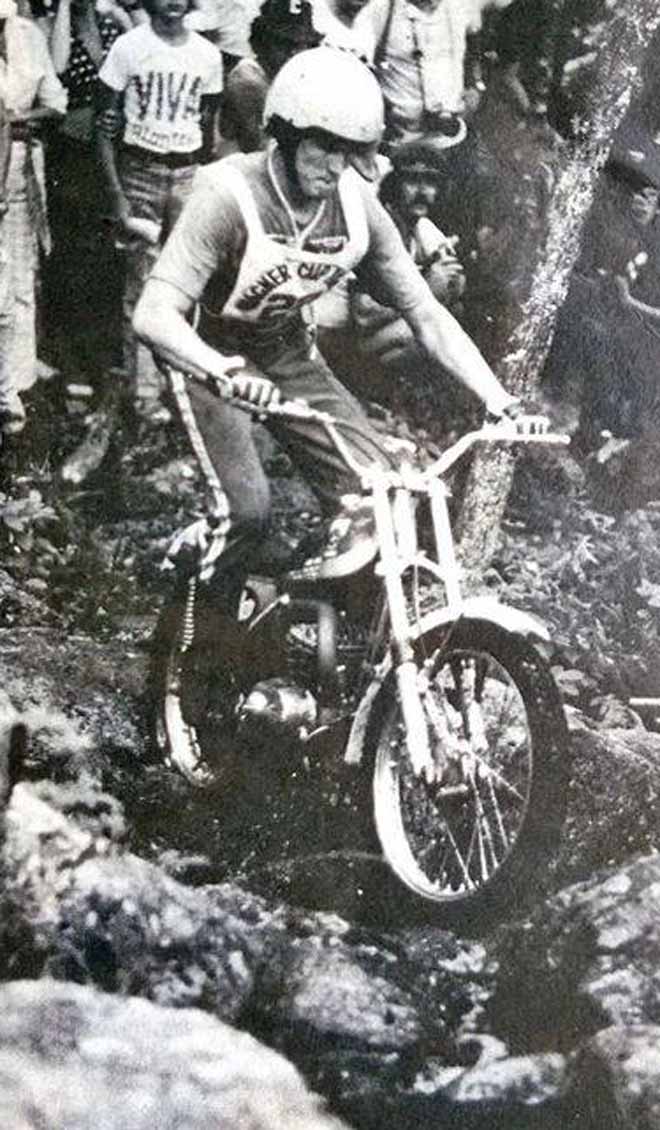
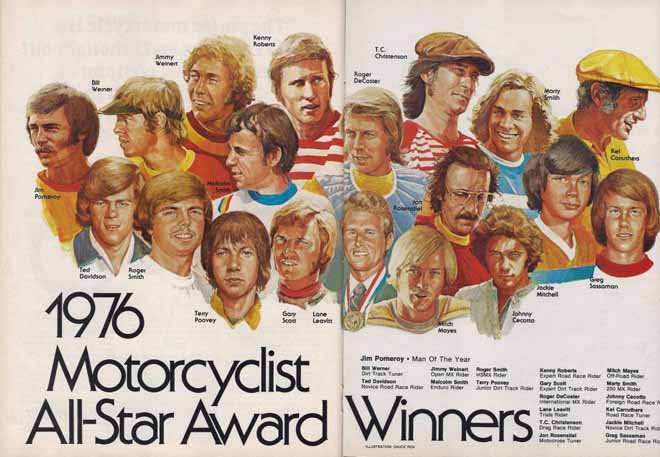
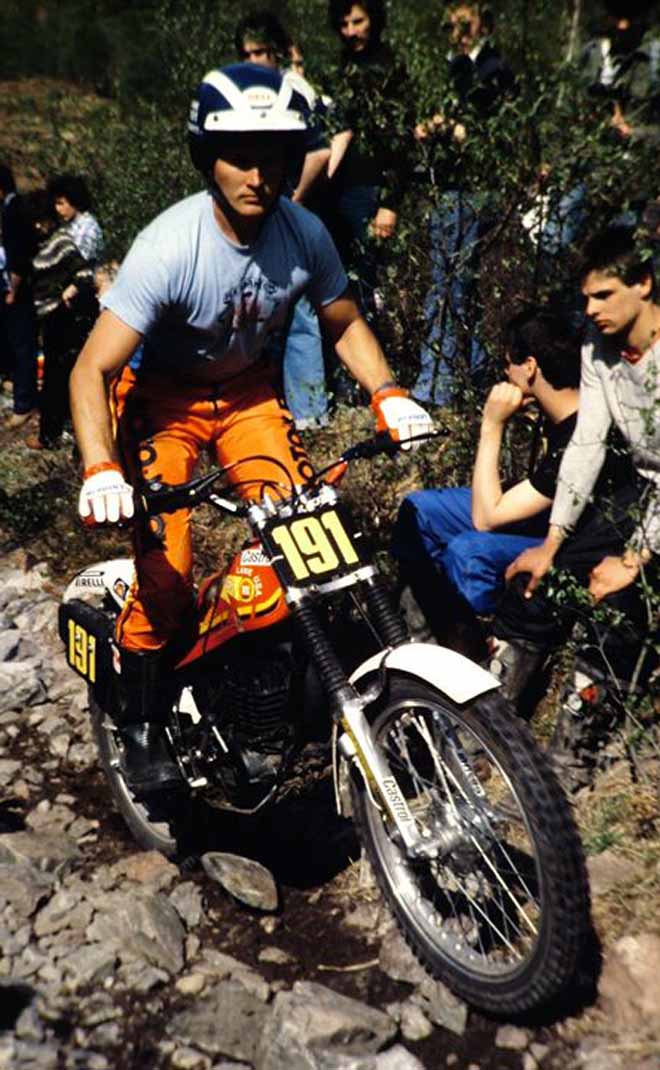
---------------------------------------------------------------------------------------
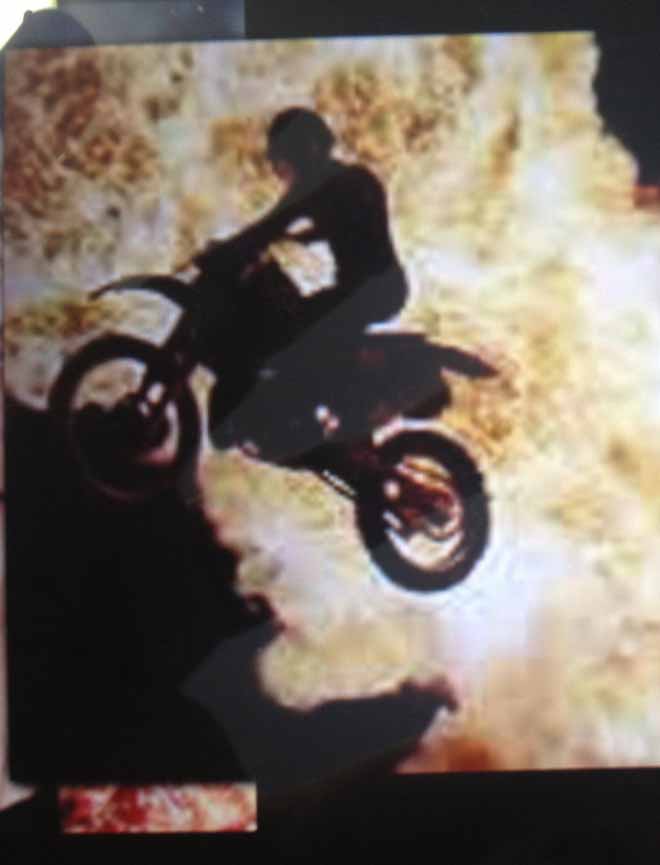
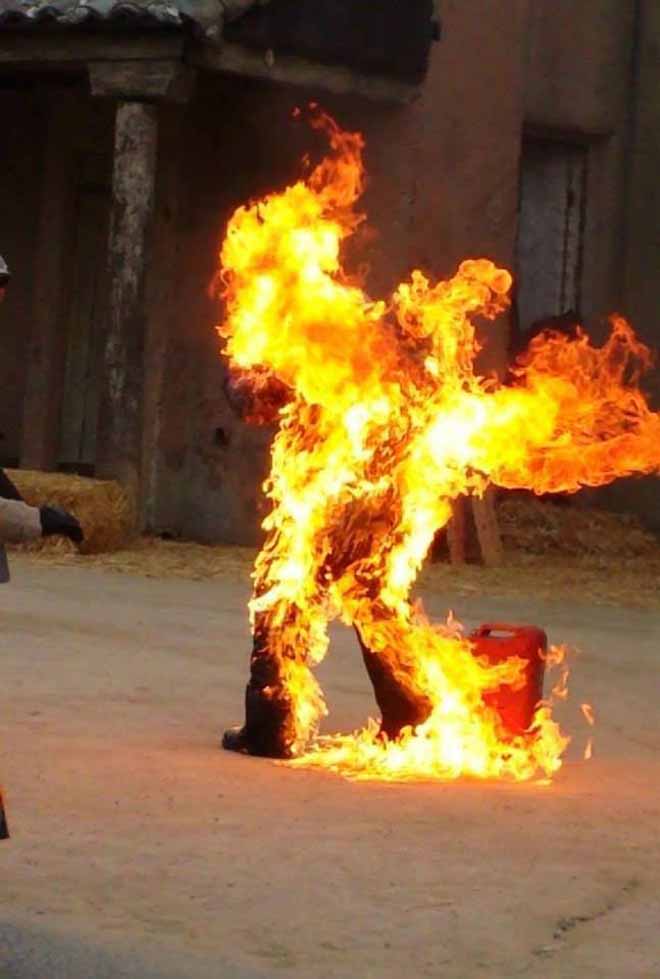
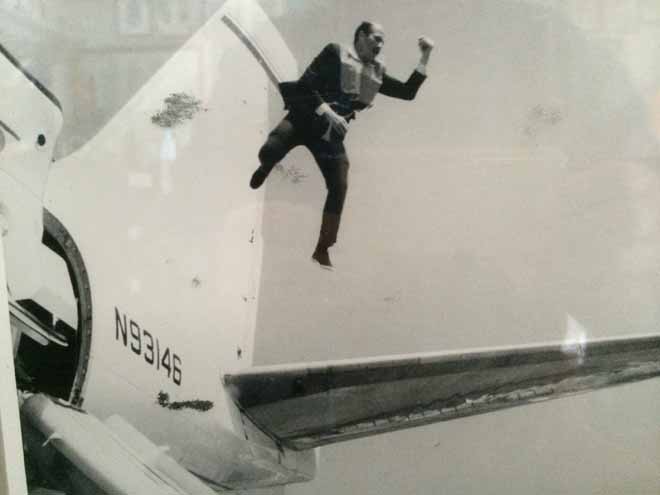
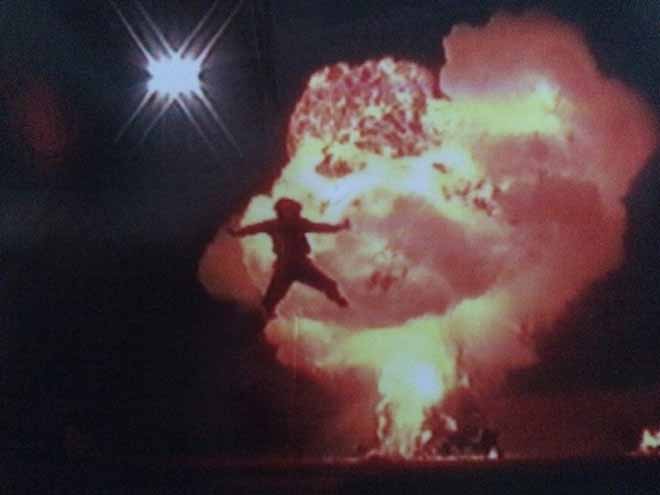
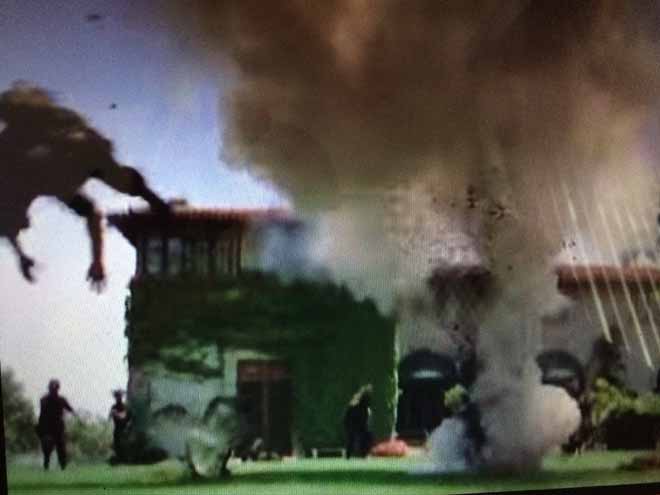
---------------------------------------------------------------------------------------
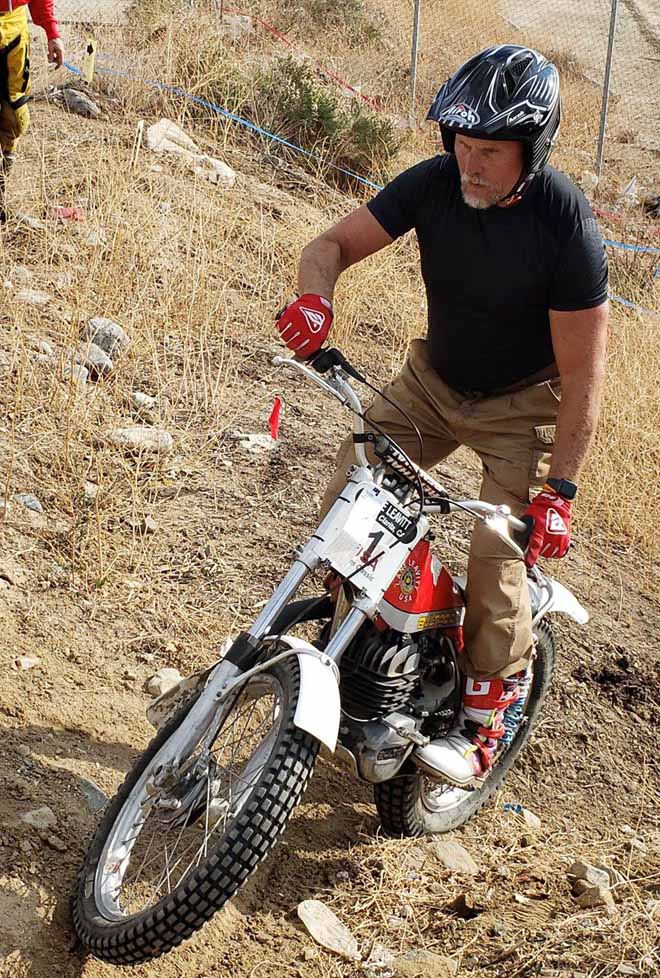
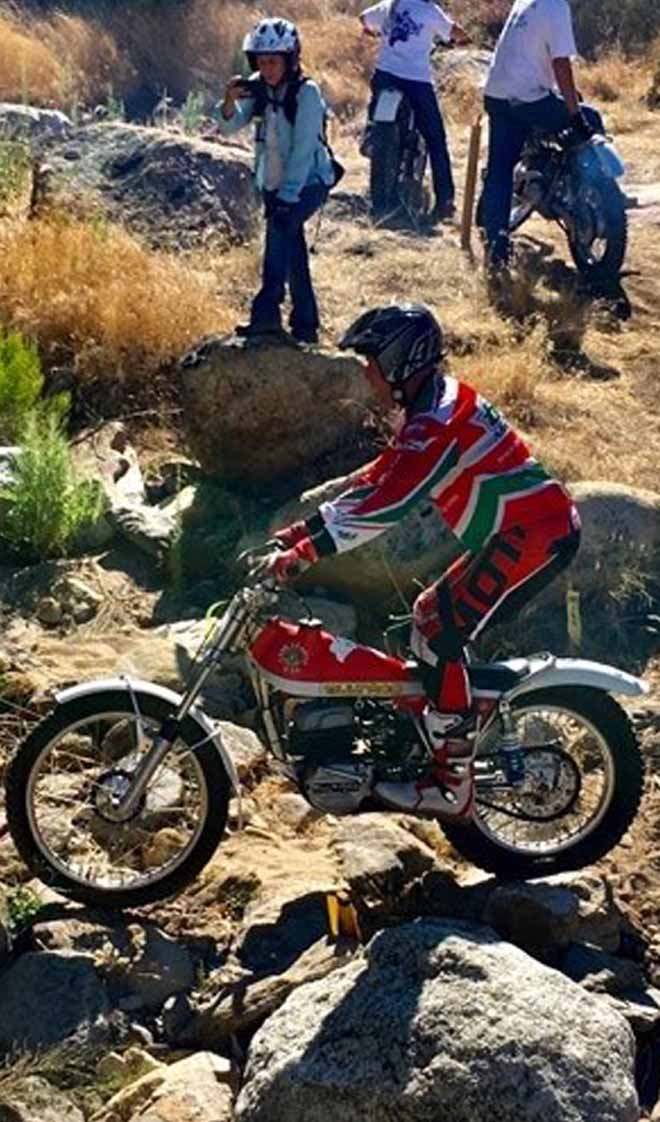
---------------------------------------------------------------------------------------

